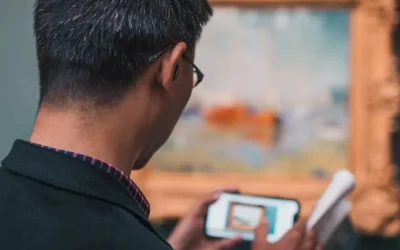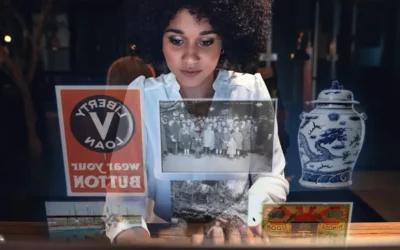5 Ways to Increase Museum Visitor Engagement (and Visits!) Via Your Collections Management System

Ron Aspe
The great thing about using your Collections Management System (CMS) to increase audience awareness and drive museum traffic is that it’s easy to do and you don’t have to buy anything. What could be better than that?
Social Media is the Key
Everyone with an opinion (or information) on any topic can post it to the internet. Facebook, Twitter, Instagram and other social media platforms are specifically designed for non-technical people. These tools offer terrific opportunities for sharing information about your museum with the rest of the world. Think of social media as an unlimited free advertising and promotion resource.
So if we can agree that the mechanics are pretty simple, what’s the challenge? If you talk to people who try to use the internet to promote non-profit organizations, they’ll tell you the hardest thing to do is create interesting information to share. That doesn’t apply to museums though, because the great thing about museums is that they are full of interesting stuff, interesting stories, and people who are passionate about sharing.
Content Marketing is the Engine!
“Content marketing’s purpose is to attract and retain customers by consistently creating and curating relevant and valuable content with the intention of changing or enhancing consumer behavior.” —The Content Marketing Institute
Doesn’t that almost sound like a museum mission statement? Just replace “consumer” with “human” in the above sentence and it aptly describes what many museums are in fact striving to accomplish.
The Tools:
Your museum’s CMS is likely bursting with relevant and valuable content. All that is required is for someone on your staff to identify the bits you want to share. Here, in a nutshell, are some strategies for getting the information out there.
- Plug your CMS into the Internet
A good CMS allows the public to browse your entire collection via the web. A great CMS will allow you to carefully control exactly what you want to share and what you don’t. All you have to do is connect your CMS to the Web. - Google It
Plugging your CMS into the web will make your content visible to those who intentionally search your collection. That’s a great start. However, wouldn’t it be terrific if you could take it to the next level by making items in your collection discoverable to people who simply do a Google search? All you have to do is flick a “virtual” switch and when someone searches for an “obsidian knife,” if there’s one in your collection, it will show up on their Google search results. If they click through, it will take them to your catalog! - Blog It
Does your museum only send out emails to remind people to renew membership? Why not let your members know about recent additions to the collection? Keep your valued members informed and engaged, even if they don’t come in. A lot of people donate to worthy causes because they believe in the good work being done. An excellent CMS makes it easy for you to harvest its content to quickly create engaging emails and blog posts. An excellent CMS allows you to link readers directly to a recently cataloged item from within any post. - Tweet It
What can you say in a Tweet? How about “Amazing new (artifact) just put on display!” with a link to your CMS! - RSS
The words corresponding to this acronym are not helpful. Thankfully, there’s Wikipedia, which describes RSS as “a family of standard web feed formats to publish frequently updated information: blog entries, news headlines, audio, video.” You need to leverage this capability, and a good CMS can automatically alert subscribers of new items in your collection via RSS, with virtually no effort on your part. - Bonus Item: Facebook
With more than one billion active users, Facebook simply can’t and shouldn’t be ignored. Great CMS systems allow users to “share” items in your museum on their personal Facebook pages with the click of a button. In all likelihood, your more passionate patrons will post your content and share it with their friends. That’s the best endorsement any museum can get!
Lucidea is completely committed to making it easy for museums to leverage the web to increase their visibility and traffic. All of the capabilities described above are embedded in our Argus collection management system. Input once, and web publish many times, through all the most-leveraged channels—and meet potential visitors where they are. Who doesn’t want to do that?

Ron Aspe
Stan writes regularly for Lucidea’s Think Clearly blog. Subscribe to ensure you never miss a post with engaging information for KM practitioners and special librarians! Learn about Lucidea’s Presto, SydneyDigital, and GeniePlus software with unrivaled KM capabilities that enable successful knowledge curation and sharing.
Similar Posts
Storytelling to Inspire Reflection Using Museum Collections Online
Storytelling with online collections is impactful, whether we choose online-only or as part of a hybrid approach to museum exhibitions.
Museum Collections Online: Learning Through Storytelling
Digitizing museum collections introduces new and engaging opportunities for storytelling. By leveraging digital surrogates—essentially online representations of physical objects—museums can enhance how they present narratives and information to audiences.
The Role of Museum Collections Online in Storytelling & Audience Engagement
Storytelling with museum collections online allows for a great degree of flexibility, offers additional detail, and lends a dynamism that is difficult to produce within a physical exhibition.
Examples of How Archives Can Be Used to Elevate Museum Collections
Last week we reviewed how archives can enhance museum collections online. This week will continue our work with an examination of specific examples, including what items different types of archives may contain and where to capture this data.



